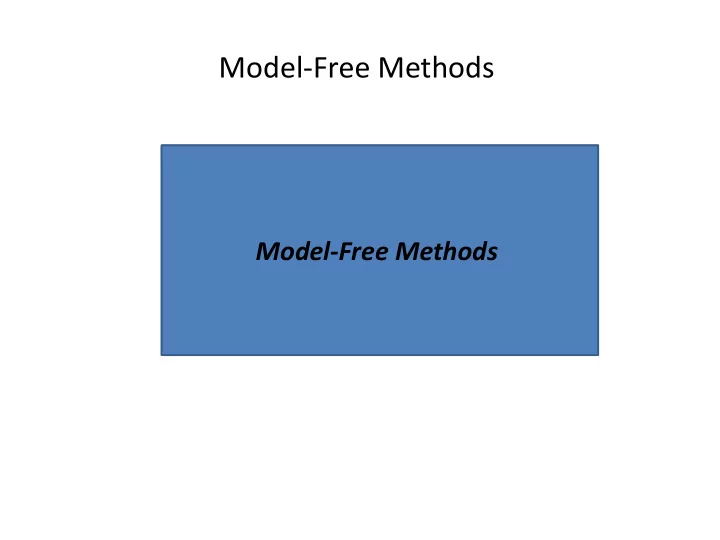

Model-Free Methods Model-Free Methods
Model-based: use all branches S 2 A 1 S 3 R=2 A 2 S 2 S 1 S 3 A 3 R= -1 S 1 In model-based we update V π (S) using all the possible S’ In model-free we take a step, and update based on this sample
Model-based: use all branches S 2 A 1 S 3 R=2 A 2 S 2 S 1 S 3 A 3 R= -1 S 1 In model-free we take a step, and update based on this sample <V> ← <V> + α (V – <V> ) V(S 1 ) ← V(S 1 ) + α [r + γ V (S 3 ) - V(S 1 ) ]
On-line: take an action A, ending at S 1 S 1 r 1 A S 2 S t S 3 <V> ← <V> + α (V – <V> )
TD Prediction Algorithm Terminology: Prediction -- computing V π (S) for a given π Prediction error: [r + γV (S') – V(S)] Expected : V(S), observed: r + γV (S')
Learning a Policy: Exploration problem: take an action A, ending at S 1 S 1 r 1 A S 2 S t S 3 Update S t then update S 1 May never explore the alternative actions to A
From Value to Action • Based on V(S), action can be selected • ‘Greedy’ selection is not good enough (Select action A with current max expected future reward) • Need for ‘exploration’ • For example: ‘ε - greedy’ • Max return with p = 1- ε, and with p=ε one of the other actions • Can be a more complex decision • Done here in episodes
TD Policy Learning ε -greedy ε -greedy performs exploration Can be more complex, e.g. changing ε with time or with conditions
TD ‘Actor - Critic’ Terminology: Prediction is the same as policy evaluation. Computing V π (S) ‘actor’ Motivated by brain modeling
‘Actor - critic’ scheme -- standard drawing Motivated by brain modeling (E.g. Ventral striatum is the critic, dorsal striatum is the actor)
Q-learning • The main algorithm used for model-free RL
Q-values (state-action) S 2 A 1 S 3 R=2 Q(S 1, A 1 ) A 2 S 2 S 1 Q(S 1, A 3 ) S 3 A 3 R= -1 S 1 Q π (S,a) is the expected return starting from S, taking the action a, and thereafter following policy π
Q-value (state-action) • The same update is done on Q-values rather than on V • Used in most practical algorithms and some brain models • Q π (S,a) is the expected return starting from S, taking the action a, and thereafter following policy π :
Q-values (state-action) S 2 A 1 S 3 Q(S 1, A 1 ) R=2 A 2 S 2 S 1 Q(S 1, A 3 ) S 3 A 3 R= -1 S 1
SARSA It is called SARSA because it uses s(t) a(t) r(t+1) s(t+1) a(t+1) A step like this uses the current π, so that each S has its a = π(S)
SARSA RL Algorithm Epsilon greedy: with probability epsilon do not select the greedy action, but with equal probability among all actions
On Convergence • Using episodes: • Some of the states are ‘ terminals ’ • When the computation reaches a terminal s, it stops. • Re-starts at a new state s according to some probability • At the starting state, each action has a non-zero probability (exploration) • As the number of episodes goes to infinity, Q(S,A) will converge to Q * (S,A).
Recommend
More recommend